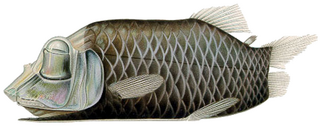
Optics is the branch of physics that studies the behaviour and properties of light, including its interactions with matter and the construction of instruments that use or detect it. Optics usually describes the behaviour of visible, ultraviolet, and infrared light. Light is a type of electromagnetic radiation, and other forms of electromagnetic radiation such as X-rays, microwaves, and radio waves exhibit similar properties.

An eye is a sensory organ that allows an organism to perceive visual information. It detects light and converts it into electro-chemical impulses in neurons (neurones). It is part of an organism's visual system.

The tapetum lucidum is a layer of tissue in the eye of many vertebrates and some other animals. Lying immediately behind the retina, it is a retroreflector. It reflects visible light back through the retina, increasing the light available to the photoreceptors.

Opahs, also commonly known as moonfish, sunfish, kingfish, and redfin ocean pan are large, colorful, deep-bodied pelagic lampriform fishes comprising the small family Lampridae.

Barreleyes, also known as spook fish, are small deep-sea argentiniform fish comprising the family Opisthoproctidae found in tropical-to-temperate waters of the Atlantic, Pacific, and Indian Oceans.
This glossary of ichthyology is a list of definitions of terms and concepts used in ichthyology, the study of fishes.

The Atlantic threadfin is a species of ray-finned fish, a threadfin from the family Polynemidae native to subtropical and temperate waters of the western Atlantic Ocean and the Gulf of Mexico.

Brachypterois serrulata, the sawcheek scorpionfish or pygmy lionfish, is a species of scorpionfish native to the northwestern Pacific Ocean.

The coral hawkfish, the pixy hawkfish or sharp-headed hawkfish, is a species of marine ray-finned fish, a hawkfish belonging to the family Cirrhitidae. It is native to tropical reefs of the Indian Ocean and the Pacific Ocean. It occasionally is found in the aquarium trade.

Bathylychnops exilis, the Javelin spookfish, is a species of barreleye found in the northern Pacific and in the eastern Atlantic Ocean near the Azores where it is found at depths of around 640 metres (2,100 ft). This species grows to a length of 50 centimetres (20 in) SL.

Cirrhibarbis capensis, the barbelled klipfish, is a species of clinid found in subtropical waters of the Atlantic Ocean around South Africa. This species can reach a maximum length of 36 centimetres (14 in) TL. This species preys primarily on benthic crustaceans, mostly amphipods and isopods. It is currently the only known member of its genus.

Etheostoma exile, the Iowa darter, is a species of freshwater ray-finned fish, a darter from the subfamily Etheostomatinae, part of the family Percidae, which also contains the perches, ruffes and pikeperches. It is native to the lakes and streams of Iowa, along with about 17 other species of darters.

Vision is an important sensory system for most species of fish. Fish eyes are similar to the eyes of terrestrial vertebrates like birds and mammals, but have a more spherical lens. Birds and mammals normally adjust focus by changing the shape of their lens, but fish normally adjust focus by moving the lens closer to or further from the retina. Fish retinas generally have both rod cells and cone cells, and most species have colour vision. Some fish can see ultraviolet and some are sensitive to polarised light.
The study of image formation encompasses the radiometric and geometric processes by which 2D images of 3D objects are formed. In the case of digital images, the image formation process also includes analog to digital conversion and sampling.

Opisthoproctus soleatus is a species of fish in the family Opisthoproctidae. It was first described in 1888 by Léon Vaillant. The species lives in most tropical seas, but is more common in the eastern Atlantic, from western Ireland to Mauritania and from Sierra Leone to Angola, and also in the South China Sea. O. soleatus can grow to a standard length of 10.5 centimetres (4.1 in) and usually live from about 500 to 700 metres deep.
Rhynchohyalus natalensis, the glasshead barreleye, is a species of barreleye found in oceans around the world at depths from 247 to 549 metres. This species grows to a length of 16 centimetres (6.3 in) SL. It and the brownsnout spookfish are the only vertebrates known to employ mirrors, in addition to lenses, to focus the images in its eyes. This fish, apart from its fluid filled dome and its mirrors, has four eyes that can see in 360°.

The fourbeard rockling or four-bearded rockling is a species of lotid fish found in the northern Atlantic Ocean. This species grows to 41 cm (16 in) in total length. It is of minor importance in commercial fisheries.

Nemipterus japonicus, the Japanese threadfin bream, is a species of marine ray-finned fish belonging to the family Nemipteridae, the threadfin and whiptail breams. This species is found in the Indo Pacific region and is an important food fish.

Sphyraena chrysotaenia, the yellowstripe barracuda, is a species of predatory, ray finned fish from the family Sphyraenidae which is found in the Indo-West Pacific region. It has entered the Mediterranean Sea from the Red Sea through the Suez Canal as a Lessepesian migrant and is now an important species in the fisheries of the eastern Mediterranean.

















